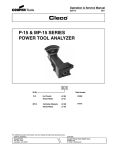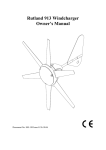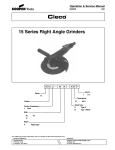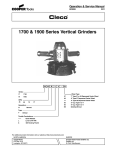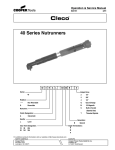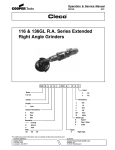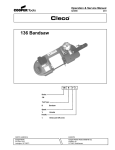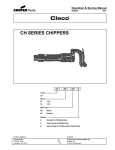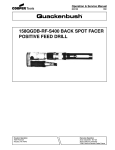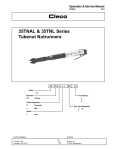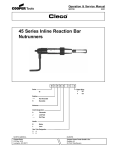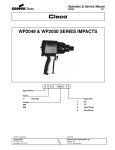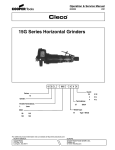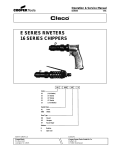Download 45 Series Pistol Reaction Bar Nutrunners
Transcript
Operation & Service Manual 823154 2/01 45 Series Pistol Reaction Bar Nutrunners 45 N P - X - Series: Nutrunner: X Output Drive: 3 3/8" 4 1/2" 45 Handle: P X - Extension: 3 3" Trigger (Stall Type) Gear Train Designation: 2 4 3 6 For additional product information visit our website at http://www.clecotools.com NORTH AMERICA CooperTools P.O. Box 1410 Lexington, SC 29071 EUROPE Cooper Power Tools GmbH & Co. Postfach 30 D-73461 Westhausen 1 Safety Recommendations For your safety and the safety of others, read and understand the safety recommendations and operating instructions before operating a nutrunner. by the tool. Tool balance arms are also available to absorb the torque reaction of the tool while balancing the weight of the tool for improved ergonomic applications. Always wear protective equipment: ! ! WARNING Impact resistant eye protection must be worn while operating or working near this tool. For additional information on eye protection and face protection, refer to Federal OSHA Regulations, 29 Code of Federal Regulations, Section 1910.133., Eye and Face Protection, and American National Standards Institute, ANSI Z87.1, Occupational and Educational Eye and Face Protection. Z87.1 is available from the American National Standards Institute, Inc., 11 West 42nd Street, New York, NY 10036. ! If the tool is to be reversed, locate torque reaction bar in a position that will resist torque reaction and prevent entrapment. See Directions on next page. Tools with clutches can stall rather than shut-off if adjusted over maximum power output of tool, or if there is a drop in air pressure. Reaction bar must be properly positioned to resist torque. Operator must release throttle to stop tool if this occurs. Do not use without properly positioned reaction bar. Reversible tools can have torque reactions in either direction. The reaction bar must be properly positioned to resist the torque reaction. CAUTION Personal hearing protection is recommended when operating or working near this tool. Hearing protection is recommended in high noise areas 85 dBA or greater. The operation of other tools and equipment in the area, reflective surfaces, process noises and resonant structures can substantially contribute to, and increase the noise level in the area. Excessive air pressure 90PSIG or worn motor components can also increase sound level emitted by tool. For additional information on hearing protection, refer to Federal Regulations, Section 1910.95, Occupational Noise Exposure, and American National Standards Institute, ANSI S12.6, Hearing Protectors. Cleco nutrunners are designed to operate on 90 psig (6.2 bar) maximum air pressure. If the tool is properly sized and applied, higher air pressure is unnecessary. Excessive air pressure increases the loads and stresses on the tool parts, sockets, and fasteners and may result in breakage. Installation of a filter-regulator-lubricator in the air supply line ahead of the tool is recommended. Before the tool is connected to the air supply, check the throttle for proper operation (i.e., throttle moves freely and returns to closed position). Clear the air hose of accumulated dust and moisture. Be careful not to endanger adjacent personnel. Before removing a tool from service or changing sockets, make sure the air line is shut off and drained of air. This will prevent the tool from operating if the throttle is accidently engaged. It is essential for safe operation that any operator of a nutrunner use good balance, sure footing, and proper posture in anticipation of a torque reaction. Insure that the operator's hand will not be wedged or pinched between the work and the tool when operating. Reaction bar nutrunners are equipped with a torque reaction bar. These bars can be braced against the work or other suitable points to absorb and relieve the operator of the torque reaction transmitted 2 CAUTION ! WARNING Repetitive work motions and/or vibration may cause injury to hands and arms. Use minimum hand grip force consistent with proper control and safe operation. Keep body and hands warm and dry. Avoid anything that inhibits blood circulation. Avoid continuous vibration exposure. Keep wrists straight. Avoid repeated bending of wrists and hands. Some individuals may be susceptible to disorders of the hands and arms when performing tasks consisting of highly repetitive motions and/or exposure to extended vibration. Cumulative trauma disorders such as carpal tunnel syndrome and tendonitis may be caused or aggravated by repetitious, forceful exertions of the hands and arms. Vibration may contribute to a condition called Raynaud's Syndrome. These disorders develop gradually over periods of weeks, months, and years. It is presently unknown to what extent exposure to vibrations or repetitive motions may contribute to the disorders. Hereditary factors, vasculatory or circulatory problems, exposure to cold and dampness, diet, smoking and work practices are thought to contribute to the conditions. Any tool operator should be aware of the following warning signs and symptoms so that a problem can be addressed before it becomes a debilitating injury. Any user suffering prolonged symptoms of tingling, numbness, blanching of fingers, clumsiness or weakened grip, nocturnal pain in the hand, or any other disorder of the shoulders, arms, wrists, or fingers is advised to consult a physician. If it is determined that the symptoms are job related or aggravated by movements and postures dictated by the job design, it may be necessary for the employer to take steps to prevent further occurrences. These steps might include, but are not limited to, repositioning the workpiece or redesigning the workstation, reassigning workers to other jobs, rotating jobs, changing work pace, and/or changing the type of tool used so as to minimize stress on the operator. Some tasks may require more than one type of tool to obtain the optimum operator/tool/task relationship. Safety Recommendations The following suggestions will help reduce or moderate the effects of repetitive work motions and/or extended vibration exposure: • Use a minimum hand grip force consistent with proper control and safe operation • Keep body and hands warm and dry (cold weather is reported to be a major factor contributing to Raynaud's Syndrome) • Avoid anything that inhibits blood circulation —Smoking Tobacco (another contributing factor) —Cold Temperatures —Certain Drugs Avoid OK Extension Neutral Avoid Flexion Avoid Neutral Ulnar Deviation • Tasks should be performed in such a manner that the wrists are maintained in a neutral position, which is not flexed, hyperextended, or turned side to side. • Stressful postures should be avoided — select a tool appropriate for the job and work location • Avoid highly repetitive movements of hands and wrists, and continuous vibration exposure (after each period of operation, exercise to increase blood circulation) • Keep tool well maintained and replace worn parts For more information on the safe use of portable air tools, see the latest edition of ANSI B186.1, Safety Code for Portable Air Tools, available from the American National Standards Institute, Inc. 11 West 42nd Street, New York, NY 10036. WARNING OVERLOADED REACTION BARS MAY BEND OR BREAK! USE THIS GUIDE FOR PROPER APPLICATION OF THE CLECO REACTION BAR. Standard Length Spindle X = 2 1/2" Minimum Y = 2 1/2" Maximum Torque Capacity = 125 Ft. Lbs. Maximum 3" Longer Than Standard Spindle X = 4" Minimum Y = 5 1/2" Maximum Torque Capacity = 80 Ft. Lbs. Maximum Avoid OK Radial Deviation ! These capacities apply to Cleco Reaction Bars code numbers: 869769-0, 869770, 202007, 202008, 202009. ! WARNING Substitute bars without proper metallurgy may not be adequate. Use Cleco reaction bars. Due to the multitude and variety of tooling applications involving reaction bar nutrunners,the "User's" Methods Engineering, Standard Tooling Engineering, and/or Safety Engineering Departments , etc. , must consider any hazards associated with each specific application of this product and provide adequate operator protection, reaction points and strengths, and operator training in the safe use of this product. This information is a compilation of general safety practices obtained from various sources available at the date of production. However, our company does not represent that every acceptable safety practice is offered herein, or that abnormal or unusual circumstances may not warrant or require additional procedures. Your work may require additional specific safety procedures. Follow these procedures as required by your company. 203185 203289 WARNING ! OVER Repetitive work motions and/or vibration can cause injury to hands and arms. Use minimum hand grip force consistent with proper control and safe operation. Keep body and hands warm and dry. Avoid anything that inhibits blood circulation. Avoid continuous vibration exposure. Keep wrists straight. Avoid repeated bending of wrists and hands. CAUTION WARNING Personal hearing protection is recommended when operating or working near this tool. ! ! Impact resistant eye protection must be worn while operating or working near this tool. Hearing protection is recommended in high noise areas (above 85 dBA). Close proximity of other tools, reflective surfaces, process noises, and resonant structures can substantially contribute to the sound level experienced by the user. 203185-4 Read Operating Instructions carefully. Follow the Safety Recommendations for your safety and the safety of others. READ OPERATING INSTRUCTIONS Do not remove this tag until the operator of this tool has read these safety precautions. Warning Labels The warning labels found on these tools are an essential part of this product. Labels should not be removed. Labels should be checked periodically for legibility. Replace warning labels when missing or when the information can no longer be read. Replacement labels can be ordered as any spare part. The reaction bar is secured to the tool and braced against the work in the opposite direction of spindle rotation. This will transfer the torque reaction from the tool to the work. 3 OPERATING INSTRUCTIONS 45 STALL-TYPE NUTRUNNERS The 45 stall-type nutrunner is designed to develop maximum rated torque at 90 psig. Torque output is controlled by a pressure regulator in the air supply line. Adjust the regulator until the desired torque is reached. REASSEMBLY The tool is reassembled in the reverse order of disassembly. Clean all parts thoroughly in solvent and inspect for damage or wear. Check all bearings for wear which can be detected by excessive end play and/or roughness which would indicate a brinelled condition. The rotor blades should be replaced every repair cycle or if they measure less than 7/32" (5.6mm) at either end. AIR SUPPLY For maximum performance, use a 3/8" I.D. air hose no longer than 8' in length. If additional length is required, a 1/2" or larger hose should be connected to the 3/8" hose. The air hose should be cleared of accumulated dirt and moisture, then a few drops of 10W machine oil should be poured into the tool's air inlet before connecting the hose to the tool. LUBRICATION An automatic in-line filter-lubricator is recommended as it increases tool life and keeps the tool in sustained operation. The in-line lubricator should be regularly checked and filled with a good grade of 10W machine oil. For proper adjustment of the in-line lubricator, place a sheet of paper next to the exhaust ports and hold the throttle open approximately 30 seconds to one minute. All the oil needed is enough to produce a light stain on the paper. If the oil mist is visible to the naked eye it is generally an excessive amount of oil. Excessive amounts of oil should be avoided. Must be replaced if 7/32" (5.6mm) or less at either end. All gear teeth, bearings, and pins should receive a close inspection and be replaced if necessary. To assemble the motor, install the rear rotor bearing into the rear bearing plate. Make sure the outer bearing race is firmly seated in the bearing plate. Clamp the rotor body lightly in the vise with the threaded end up and slip the rear bearing plate assembly onto the rotor shaft far enough for the bearing lock nut to start. Tighten the lock nut until there is approximately .0015" clearance between the rotor and bearing plate. The outer bearing race should be firmly seated and the rotor bumped forward when checking this clearance as shown in drawing below. Application of the tool should govern how frequently it is greased. It is recommended that the idler gears and right angle gears receive a generous amount of No. 2 Moly grease through the grease fittings after 40 hours of operation. STORAGE In the event that it becomes necessary to store the tool for an extended period of time (overnight, weekend, etc.), it should receive a generous amount of lubrication at that time and again when returned to service. The tool should be stored in a clean and dry environment. SERVICE INSTRUCTIONS .0015" Clearance SOFT JAWED VISE DISASSEMBLY — GENERAL Stall Tools To disassemble the tool, clamp the handle, 869755, in a vise and unscrew the gear case, 869762. The motor unit may now be removed from the handle. The gear train should be removed from the rear of the gear case, 202325. The 2nd reduction idler gears are removed from the spider by driving the idler gear pins out the rear of the spider. To disassemble the motor unit, clamp the cylinder, 864236, in the vise with the gear end of the rotor up. Note: Rotor pinion, 867524, used on the - 4 and -6 gear trains should be removed from the rotor. Use a softfaced hammer to drive the rotor out of the front rotor bearing, No. 619377. Be careful not to damage the rotor. The front bearing plate, 869054, cylinder, 203169, and rotor blades, may now be removed from the rotor. Clamp the body of the rotor in the vise and unscrew the rotor lock nut, 865352, to remove the rear bearing plate, 869055, and rear rotor bearing, 843444. Unscrew the inlet bushing, 833471, for inspection and cleaning of the inlet screen, 869548. Wash the screen in a solvent and blow out in the reverse of normal air flow. If the screen is damaged or torn it should be replaced. The muffler, 869764, may be removed for cleaning by removing the retainer ring, 619016, and exhaust screen, 412775. 4 Pack both rotor bearings with a good grade of No. 2 Moly grease after assembly of the motor unit. Note: During reassembly of the complete tool, it is important that the motor be free. After the tool is completely assembled, the square drive spindle should turn freely using a small hand wrench. If the spindle does not turn freely, the motor should be checked for proper spacing. Do not run the tool until the spindle turns freely. Failure to do this could result in damage to motor components. During reassembly of the gear train all of the various gears and bearings should receive a generous amount of No. 2 Moly grease. Pour a few drops of 10W machine oil into the air inlet after complete assembly to insure immediate lubrication of all motor parts when air is applied. 45 & 55 INLINE REACTION BAR NUTRUNNER GEAR TRAINS Part No. 844774 844774 844774 844774 Part No. 203106 203107 203106 203107 Part No. 867526 867526 867523 867523 Model -2 -3 -4 -6 204809 Model -2 -3 -4 -6 Part No. NONE NONE 867524 867524 832125 Model -2 -3 -4 -6 844774 865576 844778 Part No. 203336 844773 203337 203336 203337 Model -2 -3 -4 -6 869767 869761 Model -2 -3 -4 -6 (Incl. in 202502) Part No. 861525 861485 861484 861486 Model -2 -3 -4 -6 202324 202502 (Incl. in 202502) REACTION BAR Complete Reaction Head Reaction Bar Bar Only Only Aluminum 869769 202009 202007 Steel 869770 202008 202007 Material Pin 884126 884126 869758 869759 869756 869757 844016 844011 844017 844014 844013 844013 3/8" Sq. Dr. 3/8" Sq. Dr. 3" Ext. 1/2" Sq. Dr. 1/2" Sq. Dr. 3" Ext. 3/8" 1/2" 3/8" 1/2" 3/8" 1/2" PARTS LIST — 45 & 55 GEAR TRAINS PART NO. NAME OF PART 202007 202008 202009 202324 202502 203106 203107 204809 832125 844011 844013 844014 844016 844017 844773 844774 844778 861484 861485 Reaction Bar Head Reaction Bar (Steel) Reaction Bar (Aluminum) Spindle Bushing Gear Case (incl. 869767 & 202324) - 2 — 2nd Red. Gear- 18T (incl. 844774) - 3, - 6 — 2nd Red. Gear- 15T (incl. 844774) 2nd Red. Gear - 2, - 3, - 4, - 6 —1st Red. Gear Pin Socket Retainer Pin Retainer Plug Spring Socket Retainer Pin Spring Ball Bearing Gear Bearing Retainer Ring - 4 —1st Red. Spider - 13T (incl. Pin) - 3 —1st Red. Spider- 19T (incl. Pin) QTY. PART NO. 1 1 1 1 1 3 3 3 3 1 1 1 1 1 1 9 1 1 1 861486 861525 867523 867524 867526 869756 869757 869758 869759 869761 869767 869769 869770 NAME OF PART QTY. - 6 —1st Red. Spider- 19T (incl. Pin) - 2 —1st Red. Spider- 13T (incl. Pin) - 4, - 6 —1st Red. Gear- 17T (incl. 844774) - 4, - 6 — Rotor Pinion 6T - 2, - 3 —1st Red. Gear - 21T (incl. 844774) 1/2" Sq. Dr. Spindle (incl. Ret. Pin) 1/2" Sq. Dr. Spindle " Ext. (ind. Ret. Pin) 3/8" Sq. Dr. Spindle (incl. Ret. Pin) 3/8" Sq. Dr. Spindle " Ext. (incl. Ret. Pin) Lock Nut Grease Seal Aluminum Reaction Bar (incl. 202007, 202008, 1 1 3 1 3 1 1 1 1 1 1 884126) 1 1 Steel Reaction Bar (incl. 202007, 202008, 884126) 884126 Pin 1 5 6 7 CooperTools 670 Industrial Drive Lexington, SC 29072 Phone: (803) 359-1200 Fax: (803) 359-2013 www.clecotools.com 8








